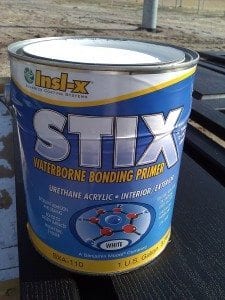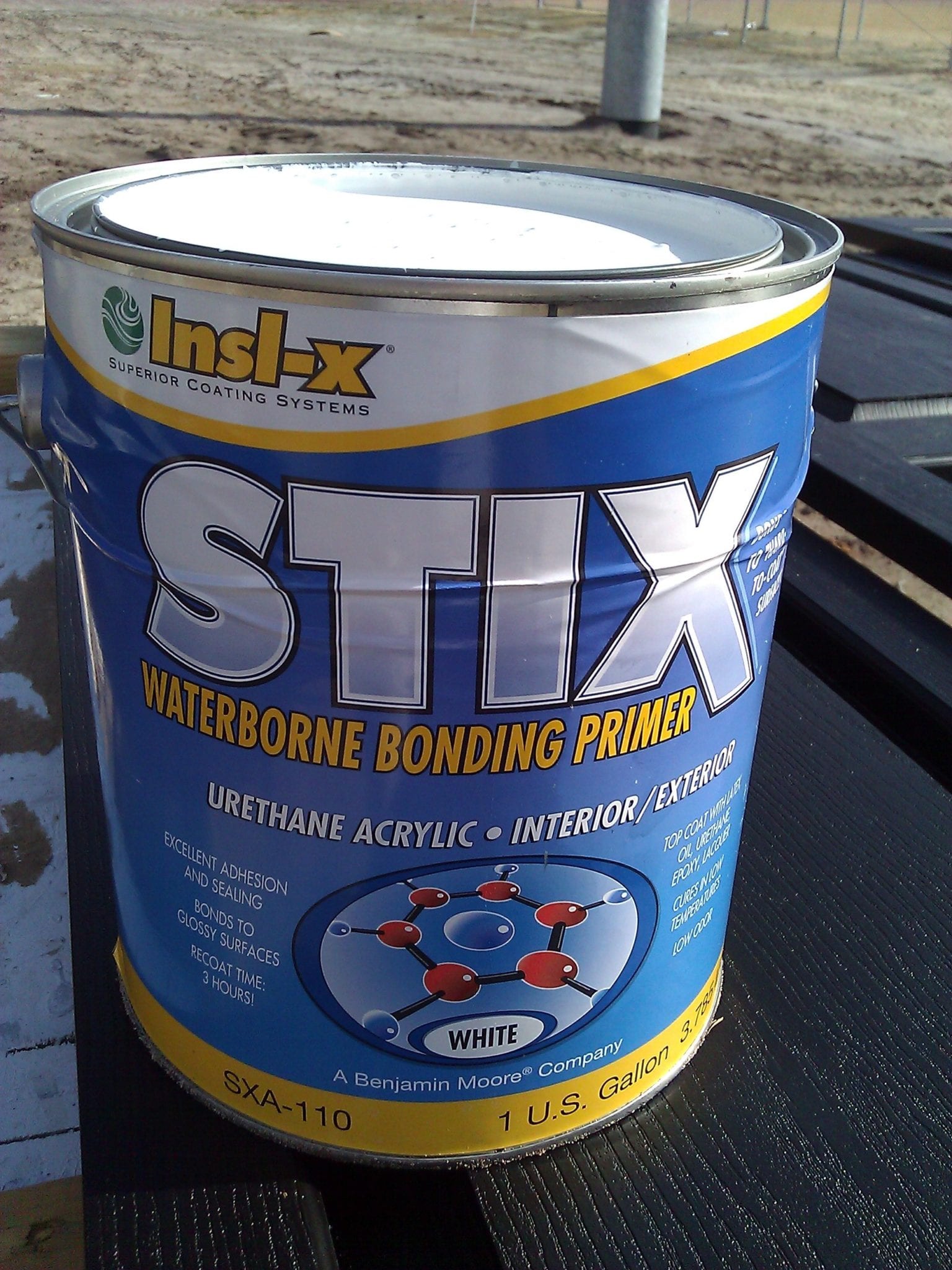Often times there is need for a bonding primer on substrates that may be troublesome. Various different plastics used in construction now are where a primer like Insl-X STIX excels. More than a name it STIX to about everything is their tag line. Below is some information directly from the TDS on usage, and acceptable substrates for STIX. Or just exactly what “everything” is.
Stix® Waterborne Bonding Primer is a premium quality, waterborne, acrylic urethane primersealer with unparalleled adhesion to the most challenging surfaces, including PVC, Vinyl, Plastic, Glass, Tile, Glazed Block, Glossy Paints, Pre-Coated Siding, Fiberglass, and Galvanized Metals.
Stix is also ideal for use on plaster, drywall, wood, and non-ferrous metals, where a low ambient or surface temperature would present a problem for conventional primers. It cures in temperatures as low as 35°F and offers an extremely hard film when cured. Use it on interior andexterior surfaces and topcoat with almost any type of coating including Alkyd, Acrylic Latex,Urethane, Epoxy, and Lacquer Finishes.
Stix® is a low VOC primer, which levels to a smooth surface and cleans up with soap and water.
Not intended for immersion service or continuous water contact. Not for below grade
applications. Not recommended for use over polyethylene, polypropylene or Kynar. Stix® must
be top coated for exterior use. Use as a spot primer only on exterior wood. On bare cedar or
redwood, use a tannin blocking prime
I haven’t really tested STIX other really hard surfaces like tile and glass, but it does a great job on vinyl and Azek. Application is very easy in both spray and brush applications. It also dries quickly, which I love. After cleaning of dust and dirt, I wiped the plastic surfaces down with denatured alcohol. It suggests using Xylene, but I don’t use it unless absolutely necessary, and there are no alternatives. Nasty.
In determining adhesion on my test areas I tried scratching it off with a five in one, and it wasn’t happening. I also did several tape tests to see if I could lift any primer, no dice there either. STIX was stuck. on both the Azek and new vinyl shutters.
Interior knotty pine stock was also primed and the sealing and hide of STIX was impressive, there was no bleed through or need for a second coat. After a days cure it was very hard, and ready to fully sand. It sanded well enough to de-bur three hours after application, so if a high build wasn’t needed you would be ready to recoat in just three short hours. The most impressive charastic to me was the spread rate, which I felt was much higher than other acrylic primers. I was able to reduce a gallon at around 8% and still have excellent hiding, so I would say 400-450 sq per gallon is very achievable. Overall I liked this primer, it does a great job with these slick and hard to work with substrates.



I have a basement (finished with heat) that has the old 9×12 probably asbestos tile, doq excrement brown. Needless to say it is like a dungeon. Would the STIX acrylic primer wdher to the vinyl tile?
If I can’t paint I will have to put down some type of flooring on top of tile.
Thanks
I think you would be best served using a paint and primer system made for flooring instead.
Contact your local paint store professional and tell them what you are doing and see what products they suggest.
I am going to try and paint ceramic tile in my bathroom. It is o my an accent color I am painting out, not exposed to water. Would stix be the right primer to use? Should I lightly sand the tile and sand between primer coats? Thanks.
Linda. I have seen glazed ceramic samples at my store where stix has been used as the primer and it worked great. Make sure you clean the tile and grout really well with a strong cleaner/de greaser first and follow the application directions on the can.
Hi, I’m painting over fiberglass and gelcoat, and I was wondering if I should wipe the surface down with MEK or denatured alcohol- which do you think will do a better job? I’m all out of xylene so those are my two alternatives.
I am painting already painted cabinets which I cleaned and sanded lightly before priming with stix. Should I sand before topcoat or just go ahead without sanding?
Susan as long as you are happy with the feel of the primer coat and there are no dust or nibs in the dried primer film sanding isn’t necessary.
Can you spray this product with an airless spray? Do you need to thin it?
It sprays beautifully, without thinning, in a graco truecoat.
Love and have used your top coat on all my vintage painting and now I’m being hired to paint kitchen cabinets which are maple and varnished. Hate sanding; can I apply stix directly over the cabinets? Don’t want to screw this up and want customers to be satisfied.
I have a wagoner sprayer and my stix primer is too thick
Can I add water to thin it in order to use in my sprayer